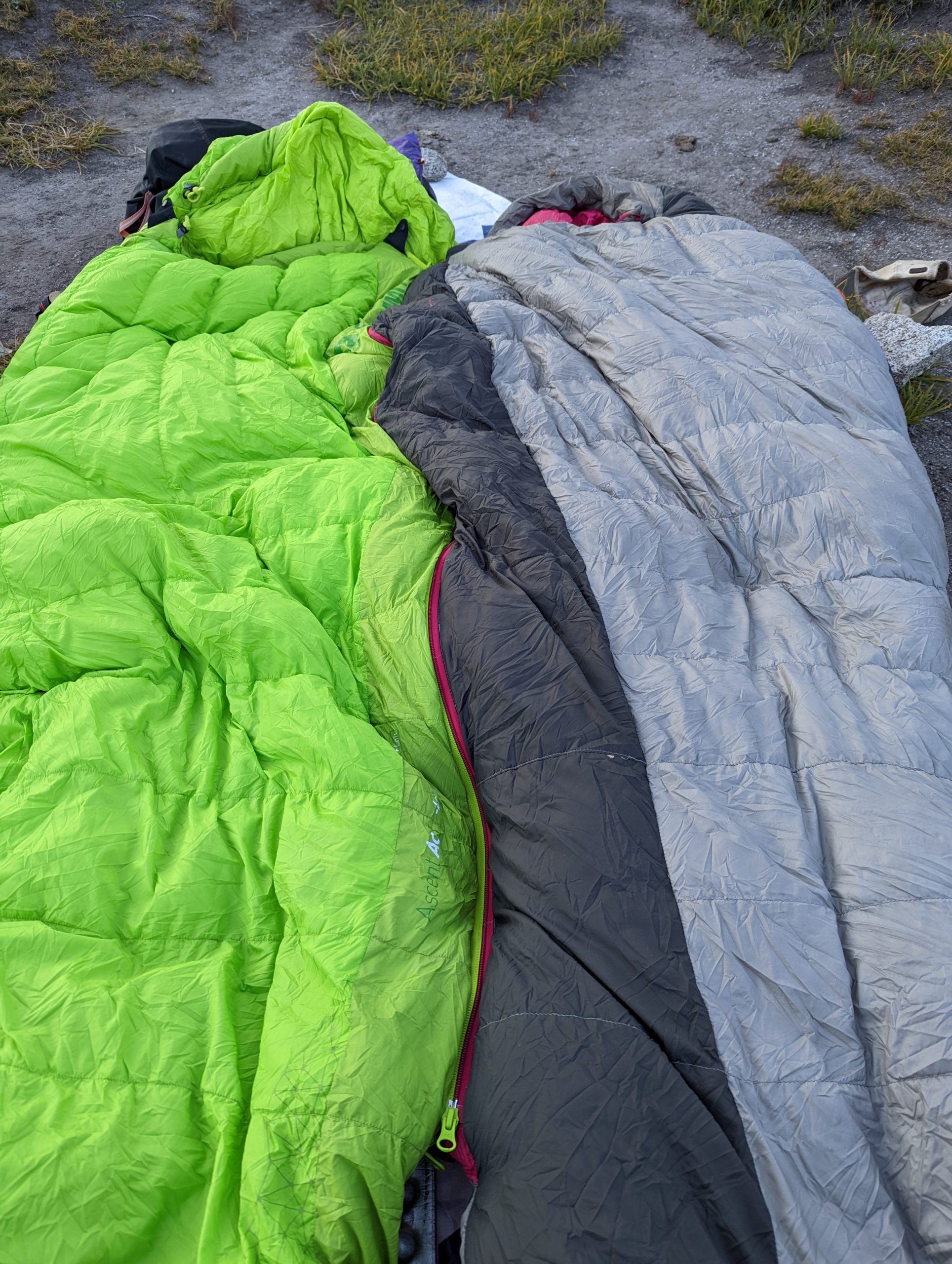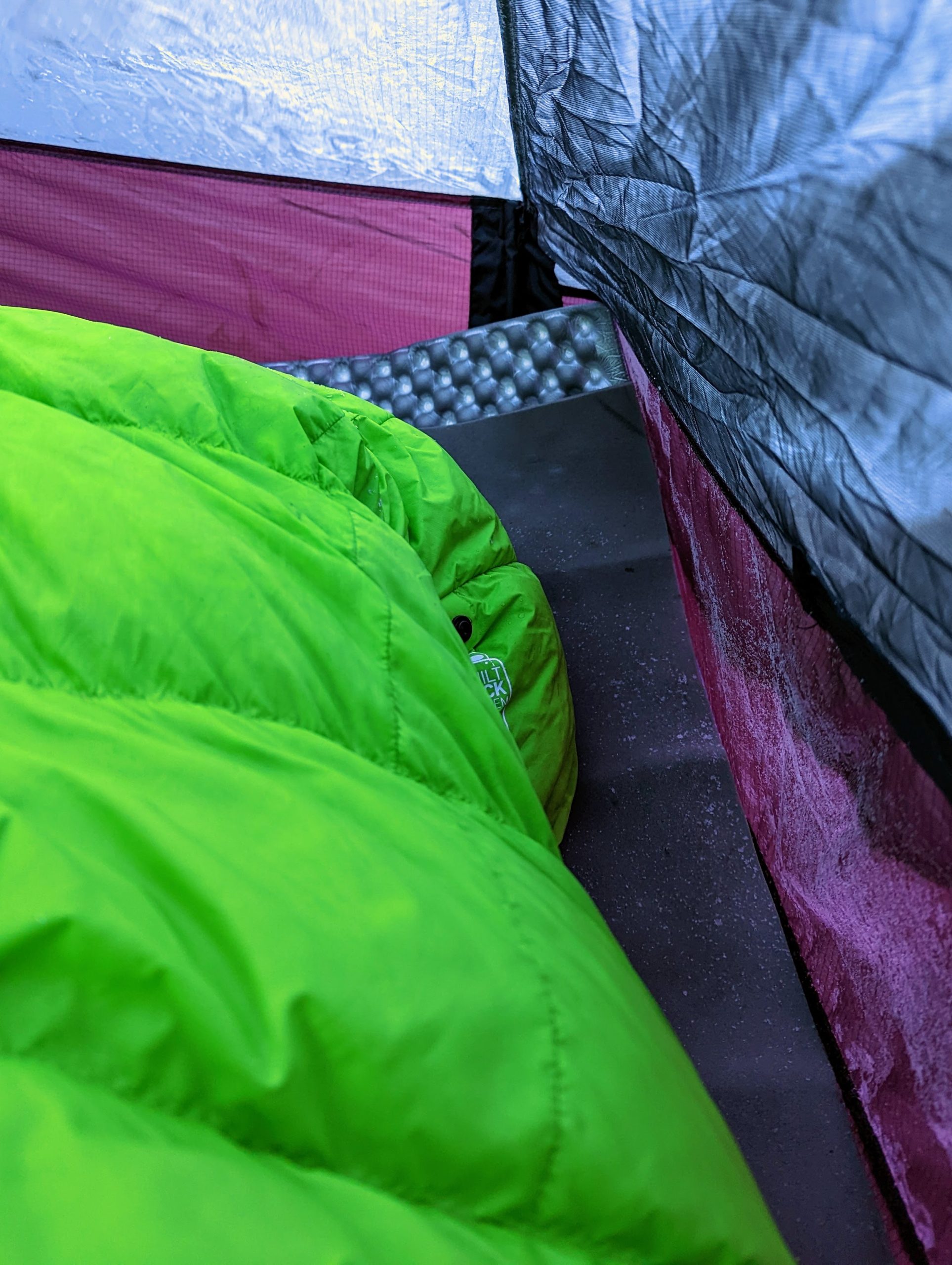Sea to Summit Ascent 25°F Down Sleeping Bag Review
Lately, I’ve really been enjoying pairing the Sea to Summit Ascent down sleeping bag with a foam pad, especially when cowboy camping. Depending on what kind of hike we’re talking about, I may be fully converted to the mummy bag/foam pad combo. It feels like they go together so naturally—like a Slim Jim and Easy Cheese on a hiker trash charcuterie. Keep reading to learn more about the Ascent mummy bag.
Sea to Summit Ascent Sleeping Bag At-a-Glance
MSRP: $369
Weight: 1lb 14.3oz
Compressed volume: 4.9 liters
Warmth Rating: 25°F/-4°C lower limit (although there are also 15° and 0° options)
Max User Height: 6ft for regular, 6’6″ for long
Materials
- Fill: Ultra-Dry Down 750+ Loft
- Shell + Liner: Lightweight 20D Nylon
Circumstances of Review
I’ve slept in the Ascent for over 20 nights and carried it in my backpack for about 500 shoulder season miles in the PNW, Utah, Colorado, and Texas. The lowest overnight temp I’ve clocked in it was 17°, and the hottest was 60°. I slept with all my layers and a liner on the 17° night (and a few other comparably cold nights) and stayed surprisingly cozy.
Likewise, on warmer nights, I experimented with multiple ways of zipping and unzipping the bag for more cooling and ventilation. Once you find your Goldilocks zone, this bag demonstrates a larger spectrum of versatility than most sleeping quilts.
Intended Use
This bag is a solid option for multi-day trips when you can reasonably predict the weather and aren’t afraid of a little temperature swing. Since it feels pretty true to its 25° rating, the Ascent thrives in situations where you may be hot when you hit the sack but cold by the time dawn is approaching. Due to its excellent water resistance, it’s a viable option for a thru-hike on the AT or a summer on the Colorado Trail.
Apart from this, it’s also a great three-season bag for cowboy camping because you can totally cocoon inside of it if you need to. It might be hard for some to justify the 30-ounce weight for a thru-hike, but the reliability of the temperature rating means you can reasonably forego a sleeping bag liner (depending on the season). Thus, the weight isn’t even that different from a quilt + liner combo.

Robin Lakes is the best cowboy camping spot in all of Washington y’all, plz enjoy & respect & deeply love it <333
Sea to Summit Ascent Features
Free Flow Zip System: This bag has what some may call a gratuitous number of zippers: six total for zippering three different sections of the bag. This is so you can retain maximum warmth on cold nights and ventilate on hot ones. The half-zip on the right side of the bag (or left side on women’s bags) provides freedom of movement and additional ventilation. It also allows the top third of the bag to be folded down as a mini quilt or fully unzipped to make a flat comforter when it’s hot.
Ultra-Dry, Non-PFC-Treated Down: A techno-babbly way of saying that this sleeping bag’s down is quicker-drying AND more water-repellent than traditional down or synthetic materials. And this is achieved without using harmful “forever chemicals” in the treatment.

Even when you get lots of condensation, the majority won’t penetrate the outer fabric to the water-repellent down within.
Thermal Efficiency: The Ascent series of bags has a few unique features for minimizing heat loss overnight. These include:
- Vertical Chest Baffles: These are said to reduce down migration compared to horizontal baffles and prevent cold spots on your torso or core. They seemed to work because I didn’t experience any cold spots.
- Oversized Hood: Featuring two different cinch cords, I enjoyed being able to really bury myself in this thing.
- Draft tubes and collar: A very important feature that you’ll definitely want when cowboy camping on a windy night.
Phone Pocket: This is a small pocket sewn on the inside of the bag for your phone or other small valuables. I ended up putting my water filter in it a few times so it wouldn’t freeze too. These pockets are pretty standard on bags these days, but having used a quilt for so long, I forgot that they existed.
Zip Coupling: Because Ascent bags have so many extra zippers, you can couple this bag with other Ascents (of the opposite sex) while remaining halfway in your own bag and retaining your own heat points. They can also be coupled with other sleeping bags with compatible zippers (YKK #5).
Sea to Summit Ascent Pros
Compressed Volume: The “tech specs” section on Sea to Summit’s website says the regular size of this sleeping bag compresses down to 4.9 liters, which is absurdly small for any sleeping bag. I’ve read in other places that Sea to Summit’s bags pack down particularly small, and I can confirm that there is still a ton of room in my pack when I pack it loose (I didn’t hike with the included compression sack, but can confirm that it also packs down small).
Warmth/Weight Ratio: With a generous 25° lower limit and a weight of 30 ounces, this bag hits the average ratio. It’s a few ounces heavier than most higher-end models in that temperature range, but that’s reflected in the price tag. Anything under two pounds is fair game for a thru-hiking sleeping bag these days, and it checks that box comfortably.
Price: $369 for a 25° bag may sound like an investment, but it’s actually on the lower end for a quality sleeping bag that can be expected to last for the duration of one or more thru-hikes.
Water Resistance: I was really impressed with how dry this bag managed to stay. Even when water got in my tent during a storm or ice formed inside from freezing condensation, it kept me totally dry inside. And the bag itself dried quickly when the shell got wet.
READ NEXT – The Best Sleeping Bags for Thru-Hiking
Sea to Summit Ascent Cons
Too Many Zippers: I don’t really have an argument against all the zippers. I just feel in my heart that six zippers is too many for one bag—even if they all serve a distinct, unique purpose. And even though they are fairly sturdy, I have no doubt that I’m going to have an issue with one of these things down the line.
“Relaxed” Mummy Fit: The Ascent was designed with a little more comfort and a little less heat retention in mind. There’s a bit more space to move around in this bag, which means there’s a bit more room to lose body heat. I hesitate to put this in the Cons section because I found that heat loss to be pretty negligible. And also found the extra space quite comfy.
Final Thoughts
If you don’t want to just take it from me, then you can also note how the Ascent checks all the boxes in the “features to look for” section of our best sleeping bags list. It does all the things that a good bag is supposed to do and tries to sweeten the deal some more with a little extra zipper versatility.
The relaxed mummy fit is also beneficial to side sleepers, and the bag itself just feels pretty all around comfy. It’s a great middle-tier option for someone who’s on a restricted budget but still wants lightweight gear that will last. Last, due to its ridiculously compressed packability, I think this bag is well-deserving of consideration for your next long hike if you’re going the bag route instead of quilts.
Shop the Sea to Summit Ascent Down Sleeping Bag
Comparable Sleeping Bags
- MSRP: $349
- Weight: 20 oz
- Temperature Limit: 30˚F
Western Mountaineering Ultralite
- MSRP: $560
- Weight: 29 oz
- Temperature Limit: 20˚F
- MSRP: $320
- Weight: 43 oz
- Temperature Limit: 20˚F
The Sea to Summit Ascent down sleeping bag was donated for purpose of review.
This website contains affiliate links, which means The Trek may receive a percentage of any product or service you purchase using the links in the articles or advertisements. The buyer pays the same price as they would otherwise, and your purchase helps to support The Trek's ongoing goal to serve you quality backpacking advice and information. Thanks for your support!
To learn more, please visit the About This Site page.

 ">
">





Comments 1
Just wanted to put out there, a more relaxed mummy fit may be a heat loss for a smaller person, or a feature that allows more people with different body shapes to comfortably use the bag. Gear is so often inaccessible to larger people, it kind of sucks to read relaxed fit as a con.